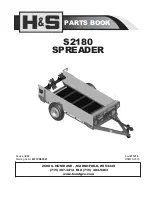
23
Section 3: Adjustments
4/03/14
PS25120 Primary Seeder 313-156M
2.
Secure seed broadcasting handle at the rear of the
seeder to the proper setting, Figure 3-1 on page 21.
3.
Complete the following procedure to calibrate
dispersal rate for your specific seed.
a. Place several pounds of seed over three of the
seed cups at the outboard end of the seeder. Do
not allow any of the seed to reach other cups.
b. Lower seeder frame onto support blocks that will
support the drive roller just above ground level.
c. Rotate drive roller by grasping the roller at the top
and pulling away from the seeder. Rotate roller to
make sure drive system is working properly and
seed cups are free from foreign matter.
d. Place a container under the three feed cups to
gather all seed as it is metered out.
e. Be sure to check the three seed cups to make sure
each cup has plenty of seed falling into it and no
other cups are receiving seed.
f. Rotate front roller by pulling the top away from the
seeder as many rotations as noted in table below.
g. Weigh the seed which has been metered out.
•
If weight is in pounds, divide total weight of
seed metered out by 3 to get the number of
pounds metered by each seed cup.
•
If weight is in ounces, divide total weight of
seed metered out by 48 to get number of
pounds metered by each seed cup.
h. Next, multiply number of pounds per cup by
number of cups on your seeder to arrive at total
pounds per 1000 sq. ft. or pounds per 1/10 acre.
i. If calculations are based on 1/10 acre, multiply
total pounds by 10 to arrive at total pounds per
acre.
j. If this figure (total pounds per 1000 sq. ft. or acre)
is different than desired, then readjust your seed
cup adjustment lever accordingly.
4.
You may want to repeat calibration procedure if
results of your calibration vary greatly from
suggested settings in the chart.
Model
No
Front Roller Rotations to Cover
1000 Sq. Ft.
1/10 ACRE
PS25120
25 rotations
107 rotations
IMPORTANT: Remember, field and seed conditions
will affect seeding rates. Check amount of seed
being using by noting acres or square feet seeded,
amount of seed added to the seeder, and level of
seed in the seed box. It may be necessary to make
minor seeding rate adjustments to compensate if
seeder has been accurately calibrated and is
seeding more or less seed than desired.
Seed Clean-Out
!
WARNING
Never use your hands, fingers or material to push seed out the
seed box discharge openings or out the seed cups. Bodily
injury can result from such practices.
It is important to clean-out the seeder box and cups after
completing a job and when storing it for long periods.
Clean seed out of the seeder as follows:
1.
Park tractor and seeder on a level smooth surface.
2.
Lower seeder frame onto support blocks that will
support the drive roller just above ground level.
3.
Place tractor selector in park, set park brakes, turn
tractor engine off, and remove switch key.
4.
Place a tarp on the ground under the seed cups to
collect seed as it falls from the cups.
5.
Refer to Figure 3-3 on page 22: Set all gate handles
on the seed cups to the full open position.
6.
Refer to Figure 3-4 on page 22: Set Seed rate
adjustment lever to the widest open position (highest
number on the indicator).
7.
Seed should free fall through the cups until seed box
is empty.
8.
If required, use a broom to finish cleaning seed out of
the seed box. Never use your hands, fingers, or
material to finish cleaning out the seed box.
9.
Remove any remaining seed from the seed cups by
rotating the top of the drive roller away from the
seeder until all seed has discharged from the seed
cups. (Approximately one to two revolutions.)
















































